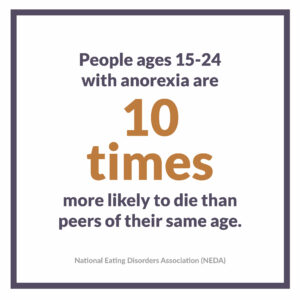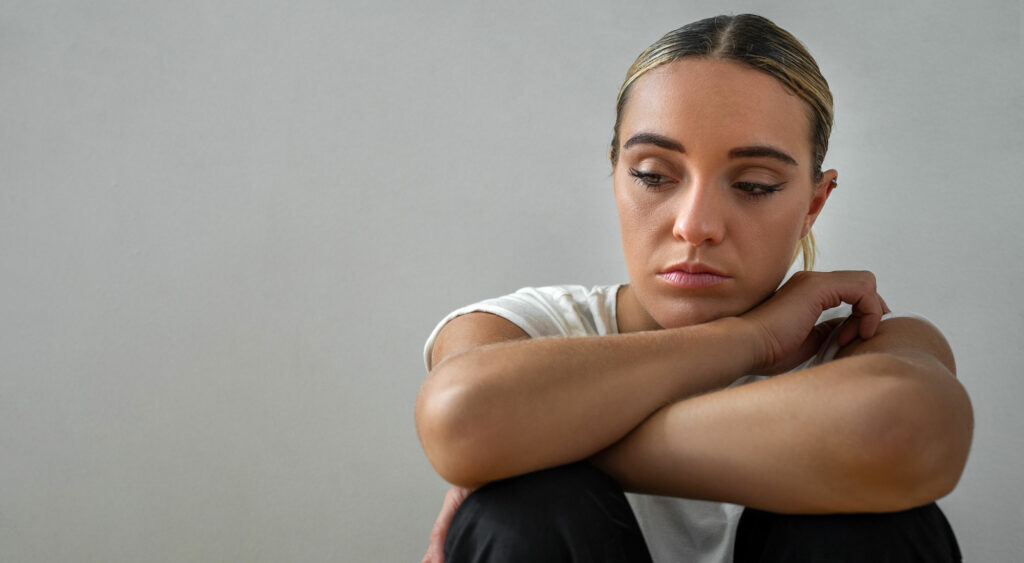By Alanna Hilbink
As we struggle to adjust to a society and a world that feels constantly changing in new and stressful ways, some of us turn to problematic behaviors to self-soothe, to gain a sense of control, or to cope when we have no other way of coping. Some of these behaviors include eating disorders like anorexia. Healthline.com defines anorexia as “a serious eating disorder in which a person adopts unhealthy and extreme methods to lose weight or avoid gaining weight.” It develops in response to your current mental health, past experiences, genetics, and other risk factors.
 Anorexia is dangerous and has a serious impact on your health. The National Eating Disorders Association (NEDA) reports that people ages 15-24 with anorexia are 10 times more likely to die than peers of their same age. This makes eating disorders the second deadliest mental health disorder. Yet despite this risk to health and life, we see anorexia on the rise. The American Journal of Clinical Nutrition found that the prevalence of eating disorders more than doubled from 2000–2006 to 2013–2018. And The New York Times reveals an even bigger leap in the need for treatment over the pandemic.
Anorexia is dangerous and has a serious impact on your health. The National Eating Disorders Association (NEDA) reports that people ages 15-24 with anorexia are 10 times more likely to die than peers of their same age. This makes eating disorders the second deadliest mental health disorder. Yet despite this risk to health and life, we see anorexia on the rise. The American Journal of Clinical Nutrition found that the prevalence of eating disorders more than doubled from 2000–2006 to 2013–2018. And The New York Times reveals an even bigger leap in the need for treatment over the pandemic.
So why is anorexia getting worse? Looking closer at what exactly anorexia is may help to explain some of the whys behind this dangerous trend.
What Does Anorexia Look Like?
Johns Hopkins Medicine explains that anorexia often begins as regular dieting. From there, the following anorexia symptoms may develop:
- Rapid weight loss
- Only eating “safe” foods or restricting entire food groups
- Ritualized behavior around food and eating (eating at certain times or in certain ways)
- Constant monitoring of and obsessing over weight or body
- Constant monitoring of and obsessing over food, nutritional content, and diets
- Excessive exercise
These are just a few of the many anorexia symptoms that NEDA lists. But among the above behavioral and physical signs, you’ll notice these symptoms look a lot like every diet and “lifestyle change” out there.
Am I Eating Healthy, or Is It Anorexia?
Given the aforementioned, one possible reason for anorexia on the rise is the concurrent rise in problematic diet fads. There’s been a push to “eat clean,” an emphasis on diets that cut out entire types of foods, and support for restricting when and how you eat. Diets like Keto, paleo, and Atkins drastically lower or cut out carbs, sugar, and other food groups entirely. And even diets that encourage eating whole foods or organic foods push a “safe” foods mindset that can quickly become limiting and problematic.
Some diets push for unusual eating patterns such as eating only on certain days, after certain times, or fasting for 24 hours or more. But dangers of intermittent fasting include a close connection to anorexia. Eating Behaviors found that intermittent fasting that had occurred in the past 12 months and 30 days was “significantly associated with eating disorder psychopathology.”
Even the most generic diets follow a “calories in, calories out” (CICO) pattern that supports eating small portions. This can make it hard for you to know if you’re eating well or if you’re hyperfixating and undereating.
Social Media and Anorexia
All of the messaging around living healthy is muddled further by the internet and social media. In Sex Roles: A Journal of Research, we learn “social media, working via negative social comparisons, transportation, and peer normative processes, can significantly influence body image concerns.” We are constantly inundated with messages to eat a certain way in order to look a certain way. Ads for diets and diet foods as well as influencers’ more subtle messages about body image and unhealthy eating behaviors are very common on social media. And some of the messages aren’t subtle at all: You can find pro-anorexia sites and communities that encourage increasingly unhealthy behaviors. Once you find them, social media algorithms are likely to keep sending related content your way.
Who Does Anorexia Affect?
You do not have to look a certain way or be a certain person to struggle with anorexia.
Another problem with social media and anorexia is that it promotes the idea that you don’t have an eating disorder unless you look a certain way. While the stereotype of a person with anorexia is typically someone who is extremely thin, anorexia symptoms can begin in people of any size and are dangerous and serious no matter what you weigh. The social media portrayals of someone with anorexia also usually include someone who is white and identifies as female, but NEDA shares that a quarter of those diagnosed with anorexia are male. Additionally, they report that despite similar rates of eating disorders among US non-Hispanic whites, Hispanics, African Americans, and Asians, people of color are significantly less likely to receive help. You do not have to look a certain way or be a certain person to struggle with anorexia.
Finding the Right Treatment for Anorexia
Eating disorders call for specialized, professional treatment. And that treatment isn’t always easy to find or afford. There may not be quality resources in your area. And even if they do exist, anorexia is getting worse, so some programs and therapists are often unable to take new patients. No matter where you are in your eating disorder and recovery journey, The Meadows Ranch is here for you each step of the way. We can assess your current situation and recommend the appropriate level of care, help you get the most out of your insurance benefits, and introduce you to our proven professionals who will give you the tools to address the unique challenges of anorexia along with any co-occurring mental health or substance use concerns. Your new life can begin today.

